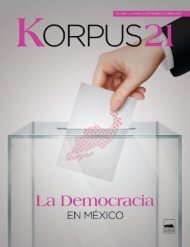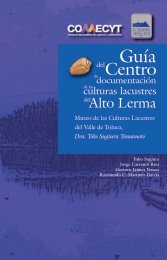You also want an ePaper? Increase the reach of your titles
YUMPU automatically turns print PDFs into web optimized ePapers that Google loves.
MARY KAY VAUGHAN, EDUCATING THE SENSES: PEPE ZÚÑIGA AND MEXICO CITY’S REBEL GENERATION<br />
protégé, Juan Ibañez, expressed the feelings of<br />
innocence and its loss, illusion and disillusion,<br />
love and frustration, trust and mistrust” (María y<br />
Campos, 1964). “The work spoke to our world, to<br />
our situation”. Pepe recalled.<br />
For Pepe, even closer to home was Gustavo<br />
Sainz’ Compadre Lobo which came out later but<br />
spoke to his personal experience. The novelist<br />
recounted a prank Pepe had undertaken as a rebellious<br />
student at La Esmeralda (Sainz, 1977).<br />
Compadre Lobo told the story of a delinquent<br />
youth, repeatedly abused, acting out in violence.<br />
He discovered his considerable artistic gifts as a<br />
student at La Esmeralda. He joined the student<br />
movement. With thousands of others, he walked<br />
in the Silent March to reject the government’s violence<br />
in September 1968. Participants covered<br />
their mouths with tape as a single loudspeaker<br />
announced their silence as a protest against<br />
the government’s refusal to dialogue (Brewster,<br />
2002). For El Lobo, these processes were transforming.<br />
He discovered his tenderness, the artist<br />
in him, and his homosexuality.<br />
In 1968, the student leaders that floated to<br />
the top had experience in Communist and other<br />
political organizations. The movement required<br />
organization, discipline, and direction. Those<br />
who gave it were versed in an old language of<br />
politics. The politics of the street spoke a newer<br />
language as Michel de Certeau has argued for<br />
the youth of Paris: a language not fully articulated<br />
in formal programs although one could<br />
argue that the basic program in Mexico reflected<br />
a broad demand: freedom for political prisoners,<br />
for political dialogue and for expression<br />
(Certeau, 1998). 8 In Paris, in Mexico, and myriad<br />
places, the language of 1968 was expressed in<br />
gestures, representations, performance, and<br />
new spontaneous communities. Nowhere was<br />
the language better articulated, according to<br />
participant Salvador Martínez Della Roca, than in<br />
the brigades that traversed Mexico City (Poniatowska,<br />
1999: 55-60). Armed with megaphones,<br />
banners, guitars, and fliers printed on mimeograph<br />
machines, they visited markets, plazas,<br />
parks, factories, movie theaters, and restaurants.<br />
They boarded buses and streetcars to “communicate”<br />
with “the people”. “There was more quality,<br />
more women, more interaction among men<br />
8 On Paris 1968, see The Capture of Speech and Other Political<br />
Writings (Certau, 1998).<br />
and women, more popular contact, music, theater,<br />
and laughter”, he recalled. 9<br />
Leader Luiz Gonzalez del Alba wrote no left<br />
group could have mobilized thousands from private<br />
and public universities and high schools,<br />
from upper-, middle-, and working-class families.<br />
He called it a festive celebration of new liberties:<br />
the clothing, the hair styles, the Beatles, sexual<br />
freedom, the possibility of escaping parental<br />
strictures, of not having to “ask permission”<br />
(González, 1993: 22-31). In chants, banners, cartoons,<br />
and insolent street language they mocked<br />
the hitherto sanctified president”. <strong>10</strong> They joyously<br />
rode atop buses they had captured waving placards<br />
and chanting Di-á-lo-go! They painted the<br />
city with their demands, denunciations, and desires—Libertad!<br />
—and their V for “Venceremos”—<br />
we will win!<br />
1968 in Mexico was not a traditional left movement:<br />
it was an antiauthoritarian movement with<br />
demands for political freedom, standard within<br />
liberalism although radical for Mexico. These<br />
were pressed in the street with overwhelming<br />
emotional drive that created a new space of<br />
solidarity, communication and liberatory behavior.<br />
They wanted dialogue with those in powernot<br />
just to listen to them, but to talk with them<br />
about rights and demands they knew to be worthy<br />
of authority’s attention and redress. The size,<br />
emotional force, and daring of this mass movement<br />
led the powerful to panic. On October 2,<br />
just two weeks after the Silent March the government<br />
opened fire on a mass rally at Tlatelolco<br />
and mercilessly repressed the movement.<br />
In late July 1968 as the student movement<br />
was getting underway, Pepe Zúñiga stood in<br />
the long line of young people waiting to enter<br />
the Teatro Jimenez Rueda in downtown Mexico<br />
City. They were going to see Cementerio de<br />
Automóviles, an adaptation of Fernando Arrabal’s<br />
1938 play directed by another Hector Azar<br />
protégé, Julio Castillo (24 years old). Felida<br />
Medina, Pepe’s classmate at the Esmeralda, did<br />
the stunning scenography. Pepe had known Felida<br />
as a proper bourgeois girl, carefully coifed,<br />
lightly made up, and very feminine in her dress,<br />
9 Particularly important for gender analysis of the brigades is<br />
the essay “Mexico 68: Defining the Space of the Movement,<br />
Heroic Masculinity in the Prison and Women in the Streets”<br />
(Frazier and Cohen, 2003).<br />
<strong>10</strong> See, among others, “Mexico ’68: Power to the Imagination!”<br />
(Soldatenko, 2005).<br />
122



![bicentenario_1[V2]](https://img.yumpu.com/68677971/1/167x260/bicentenario-1v2.jpg?quality=85)
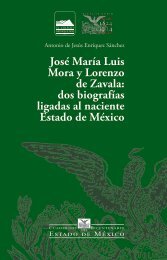
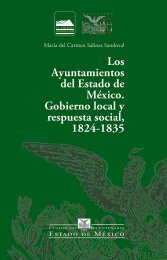

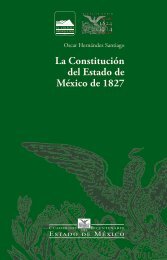
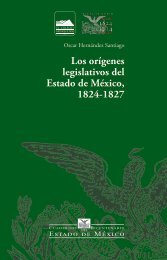
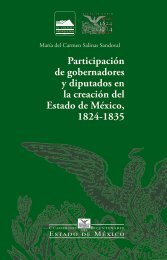
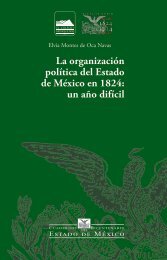
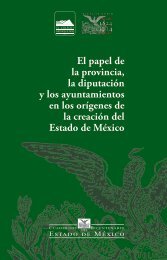
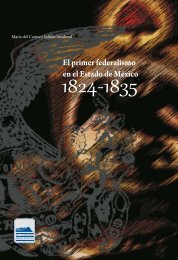
![El_primer_federalismoEM[final]_compressed (2)](https://img.yumpu.com/68483279/1/178x260/el-primer-federalismoemfinal-compressed-2.jpg?quality=85)
